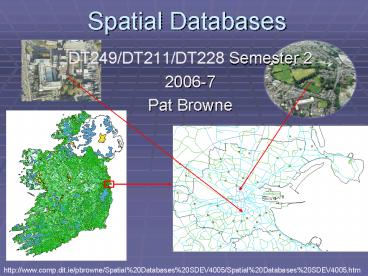Spatial Databases - PowerPoint PPT Presentation
1 / 20
Title: Spatial Databases
1
Spatial Databases
- DT249/DT211/DT228 Semester 2
- 2006-7
- Pat Browne
http//www.comp.dit.ie/pbrowne/Spatial20Databases
20SDEV4005/Spatial20Databases20SDEV4005.htm
2
Course Web Page
http//www.comp.dit.ie/pbrowne/Spatial20Databases
20SDEV4005/Spatial20Databases20SDEV4005.htm
3
Your Interest in Spatial Databases Jobs in GIS
- Government
- Most major departments are developing GIS on an
ongoing basis e.g. the Geological Survey of
Ireland (GSI), Environment Protection Agency
(EPA), Duchas, OPW. - Semi-states
- Many agencies have a big investment in GIS e.g.
ESB. - Local Authorities
- County councils run many GIS applications.
- Private Sector
- MAPFLOW, IMGS (Information with location).
- Post graduate research
- DIT Digital Media Centre (DMC), The National
Centre for Geocomputation (Maynooth). - Several DT249 students have found new career
opportunities as a direct result of completing a
spatial database project.
4
Your Interest in Spatial Databases Technically
Interesting
- Spatial databases provided the essential logic
and structure for a host interesting and creative
applications (e.g. emergency services routing,
hospital placement, a game environment). - The spatial database course brings together many
topics that you have already studied (e.g.
databases, graphics, objection orientation, web
development) and applies them in innovative ways. - Spatial databases can answer a range of questions
from where is the nearest chipper? to is
Sellafield killing us?. - Spatial database work with many other
technologies (e.g. Internet ,wireless networks,
and GPS.) Great source of ideas for final year
project.
5
What is a Spatial Database?
- A spatial database is a database system that is
optimized to store, update and query spatial
objects - Point a house, a moving car
- Line a road segment
- Polygon a county
6
Why Spatial Databases?
- Queries to databases are posed in high level
declarative manner (usually using SQL) - SQL is the lingua-franca in the commercial
database world - Standard SQL operates on relatively simple data
types - Spatial SQL (SQL3/OGIS) supports several spatial
data types and operations - Additional spatial data types and operations can
be defined in spatial database. (CREATE TYPE
statement) - A DBMS is a way of storing information in a
manner that - enforces consistency,
- facilitates access,
- Allows users to relate data from multiple tables
together
7
Spatial Databases must integrate with other
applications and data.
HTML Viewer Java Viewer
GIS Desktop Applications
(Internet)
Wireless Mobile Devices
Network
Map Renderer
Server Side Applications
Spatial DB
8
Query 1
- Display all counties that border Kildare.
- This query can be implemented using the following
SQL command - select c1.name as name,transform(c1.the_geom,4326)
as the_geom - from county c1,county c2
- where
- touches(c1.the_geom,c2.the_geom)
- and
- c2.name'Kildare'
9
Result 1
10
Query 2
- Display all regional roads that intersect the
N7 National Primary Road within the region of
Dublin Belgard This query can be implemented
using the following SQL command - SELECT r.class as name,transform(r.the_geom,4326)
AS the_geom - FROM regional_road r,national_primary_road
n,county c - WHERE
- n.class'N7'
- AND
- n.the_geom r.the_geom
- AND
- intersects(n.the_geom,r.the_geom)
- AND
- c.name'Dublin Belgard'
- AND
- contains(c.the_geom,intersection(r.the_geom,n.the_
geom))
11
Result 2
12
Course Overview
- This course focuses on the use of database
management systems (DBMS) to store spatial
information. A spatially enabled DBMS is a
central component of a Geographical Information
System (GIS). GIS has a major role to play in
managing the national physical and informational
infrastructure. An understanding of spatially
enabled DBMS is vital in implementing any
information system where geographic data is
required. This course focuses on the role of the
DBMS in geographical applications.
13
Course Description 1
- Foundations Fundamental geographic concepts for
GIS The world in spatial terms, how natural and
man made features can be stored in a DBMS.
Qualitative and quantitative location e.g.
geo-referencing and coordinate systems. Maps as
representation of the world and of information.
Geometric and thematic information.
14
Course Description 2
- Algorithms for GIS Intersection of lines,
operations on polygons, network traversal,
auto-correlation, statistical operations,
searching. We focus on the use of algorithms, not
their design. The algorithms are provided as
database extensions (e.g. PostGIS) or Java APIs
(e.g. Open Map, Geotools, uDig, JUMP)
15
Course Description 3
- Spatial representations Raster, vector, TIN,
quadtrees, R-trees, scan orders, polygon
coverage, discrete objects, networks, time,
connections and topology, networks, distance and
direction, flow and diffusion, spatial
hierarchies, boundaries, spatial patterns,
attributes of relationships. As with the
algorithms these representations are provided by
the DBMS and APIs.
16
Course Description 4
- Applications of geospatial data Transportation
networks, natural resources, soil data,
oceanography, land cover, geology, climate,
terrain modelling, land records, administrative
boundary data, demographic studies, decision
support and health data.
17
Course Description 5
- Spatial databases Spatial data definitions,
formats, models, queries the relational model,
advanced SQL, data modelling techniques,
implementing a simple database, post relational
database models, object-relational and
object-oriented models, spatial data structures,
spatial indexing e.g. R-Tree, networking,
database issues in GIS. The course will involve
practical work on a range of appropriate software
e.g. PostgreSQL, PostGIS, GML, Java, ArgoCaseGEO,
OPENMAP, uDIG .
18
Learning Outcomes
- On completion of the spatial database module, you
will be able to - use a database to store and query spatial data
- develop applications that use a spatially
enabled DBMS - understand and use the OGC simple feature model
- distinguish and use appropriate database models
- understand the DBMS extensions and APIs required
by application programs to handle spatial data.
19
Course Text
The course text is Spatial Databases With
Application to GIS by Philippe Rigaux, Michel
Scholl, and Agnès Voisard Publisher
Elsevier Google Books
20
Good Reference
Spatial Database Book Project http//www.spatial.c
s.umn.edu/Book/































